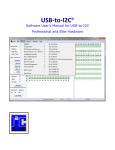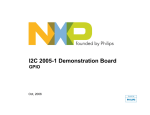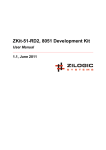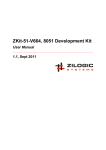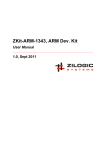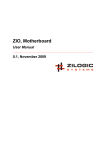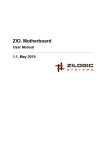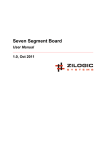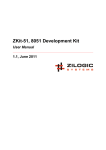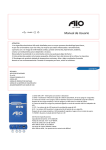Download Temperature Sensor Board
Transcript
Temperature Sensor Board User Manual 1.0, Oct 2011 Temperature Sensor Board User Manual Rev. 1.0 This work is licensed under the Creative Commons Attribution-Share Alike 2.5 India License. To view a copy of this license, visit http://creativecommons.org/licenses/by-sa/2.5/in/ or send a letter to Creative Commons, 171 Second Street, Suite 300, San Francisco, California, 94105, USA. Temperature Sensor Board User Manual Rev. 1.0 Table of Contents 1. Temperature Sensor Board ..................................................................................................... 1. Overview ....................................................................................................................... 2. Board Features .............................................................................................................. 3. Locating Components ..................................................................................................... 4. Description ..................................................................................................................... 5. Power Supply ................................................................................................................ 6. Remote Sensor .............................................................................................................. 7. Connectors and Headers ................................................................................................ 8. Specifications ................................................................................................................. 2. Board Usage .......................................................................................................................... 1. I²C Bus Overview ........................................................................................................... 2. Accessing Device Registers ............................................................................................ 3. Common Usage Scenarios ............................................................................................. A. Legal Information ................................................................................................................... 1. Copying ......................................................................................................................... 2. Disclaimers .................................................................................................................... Zilogic Systems 1 1 1 1 1 2 2 3 4 5 5 5 5 9 9 9 Page iii Temperature Sensor Board User Manual Rev. 1.0 Chapter 1. Temperature Sensor Board 1. Overview The temperature sensor board is based on NXP’s SA56004 temperature sensor which can be interfaced through the I²C bus. Temperatures can be measured with an accuracy of ±1 °C. 2. Board Features • SA56004, I²C temperature sensor • Remote temperature measurement • Over temperature alert interrupt • External device control, without software intervention • LED indications for testing/debugging • Can measure temperatures from -40 °C to 125 °C. 3. Locating Components The location of the components on the board is indicated in the following diagrams. Figure 1.1. Front View 4. Description A block diagram representation of the board is shown below. The I²C temperature sensor can be accessed through the 10 pin FRC connector from the motherboard. The temperature sensor can measure the local IC temperature, and a remote temperature. For measuring remote temperatures a transistor connected to the REMOTE SENSOR port is used as the sensing element. Zilogic Systems Page 1 Temperature Sensor Board User Manual Rev. 1.0 An alert interrupt is raised when the temperature exceeds a configurable set point. The signal T_CRIT is raised when the temperature exceeds a configurable critical set point. This is useful for automatic temperature regulation applications, where the system is to be shutdown or a fan is to be switched ON, without software intervention. The board provides a isolated 12V/1Amp power switching. The board switches ON the 12V/1Amp DC OUT on T_CRIT assertion and switches OFF the DC OUT on T_CRIT de-assertion. DC OUT can be connected to a 12V fan to switch it on and off automatically on thermal critical points. Figure 1.2. Block Diagram 5. Power Supply The temperature sensor board is powered from the motherboard through FRC-10 header. The DC OUT can be used for controlling an external device, like a fan or a relay. If external device control is required, an external 12V/1Amp DC power should be provided through the DC IN screw terminal or through the +12V IN power jack. This will be driven out through DC OUT on T_CRIT assertion. Output Voltage 12V Output Current 1A Polarity 6. Remote Sensor For remote temperature measurement, the Emitter-Base diode of a BJT, is used as the sensing element. Note that two-lead diodes cannot be used, since the ideal factor of two-lead diodes is incompatible with the temperature sensor. The recommended transistors are listed below. • 2N3904 (NPN) • 2N3906 (PNP) An example of an 2N3904 NPN transistor connected to the REMOTE SENSOR connecter is shown in the following diagram. Zilogic Systems Page 2 Temperature Sensor Board User Manual Rev. 1.0 Figure 1.3. Connecting Sensing Element The wires connecting the sensing element can be 8 inches long. For longer wire lengths a shielded twisted pair is recommended. Please see the recommendations under the section "Mounting" of the SA56004X data sheet. 7. Connectors and Headers 7.1. I2C Connector The temperature sensor board can be interfaced to a motherboard through the I2C, 10 pin FRC, connector. The signal details are given below. Table 1.1. FRC-10 Pin Connector Pin # Signal Signal Type 1 VCC Supply from motherboard 2 Not Used - 3 Not Used - 4 SCL Open collector 5 SDA Open collector 6 Not Used - 7 Not Used - 8 Not Used - 9 INTR# TTL Out 10 GND - 7.2. REMOTE SENSOR Connector When a remote temperature has to be measured, the remote temperature sensing element is connected to the REMOTE SENSOR header. Table 1.2. REMOTE SENSOR Connector Pin # Signal 1 GND 2 D+ 3 D- 4 GND 7.3. DC OUT and DC IN Connector This DC OUT connector provides a 12V DC from the DC IN connector when T_CRIT is asserted. This is typically used for controlling a fan, or triggering a system shutdown, when the temperature exceeds a configured critical set point. Zilogic Systems Page 3 Temperature Sensor Board User Manual Rev. 1.0 Table 1.3. DC OUT and DC IN Connector Pin # Signal 1 VCC 2 GND 8. Specifications Table 1.4. Specifications Parameter Value Condition Power Supply Supply Voltage 5V Supply Current 550uA - 600uA 16Hz conversion rate FIXME Temperature Measurement Range -40 °C - 125 °C Local Temp. Error ±2 °C +60 °C to +100 °C ±3 °C -40 °C to +125 °C ±1 °C +60 °C to +100 °C ±3 °C -40 °C to +125 °C Remote Temp. Error I²C Bus Input High Voltage 2.2V - 5.0V Input Low Voltage 0.0V - 0.8V Max. SCL frequency 400kHz 7-bit Device Address 0x48 Zilogic Systems Page 4 Temperature Sensor Board User Manual Rev. 1.0 Chapter 2. Board Usage 1. I²C Bus Overview The I²C is a simple two wire interface for on-board communication. One of the wires is data and the other is clock. The I²C is a master slave bus. The master is initiates the communication and the slaves respond to it. Each slave on the bus has an address to uniquely identify itself. Figure 2.1. I²C Bus There are typical two operations that the master can perform i2c_read and i2c_write. During the i2c_read operation the master specifies the slave address and the no. of bytes to read. During the i2c_write operation the master specifies the slave address and the bytes to be written. 2. Accessing Device Registers The devices usually have a set of registers. Each register is given an address. When a register is to be read or written, the address is first written to the device and then data is read or written to the register. The register address specified is stored within the device. For successive reads to the same register the address need not be specified again. 3. Common Usage Scenarios This section shows the pseudo-code for various common usage scenarios. The I²C operations are represented by the following two functions. data = i2c_read(dev_addr); i2c_write(dev_addr, data); The dev_addr is the 7-bit I²C address of the device to read/write. data is the byte to be read/written. In the case of i2c_read() the byte read from the device is returned. In the case of i2c_write() the byte to be written to the device is passed to the function. Scenario I: Measuring Local Temperature. To measure the local temperature the following pseudo code can be used. lthb_reg = 0x0; i2c_write(0x48, lthb_reg); ❶ temp = i2c_read(0x48); ❷ ❶ ❷ Write the register address of the local temperature register (LTHB), 0x0. Read the contents of LTHB. The read byte is the local temperature in degree Celsius. Scenario II: Measuring Remote Temperature. The temperature sensing element, is first connected to the SENSOR PORT as shown in the following diagram. Zilogic Systems Page 5 Temperature Sensor Board User Manual Rev. 1.0 Figure 2.2. Connecting Sensing Element The following pseudo code is used to measure the remote temperature. rthb_reg = 0x1; i2c_write(0x48, rthb_reg); ❶ temp = i2c_read(0x48); ❷ ❶ ❷ Write the register address of the remote temperature register (RTHB), 0x1. Read the contents of RTHB. The read byte is the remote temperature in degree Celsius. Scenario III: Interrupt Notification. In certain applications, an action has to be taken when the temperature exceeds a specific temperature range. This can be done by periodically reading the temperature register. But a much more efficient method is possible. The temperature sensor can interrupt the CPU, when the temperature exceeds a specified range. The CPU then performs the required action, and acknowledges the interrupt. Figure 2.3. Alert Interrupt The temperature sensor has an ALERT signal that can be used as an interrupt signal. The set points for local and remote temperatures can be configured individually. An example circuit configuration is shown in Figure 2.3, “Alert Interrupt”. Note that since the ALERT is an open collector output a pull-up resistor (typically 10k) is required. The pseudo code for enabling interrupt notification when the local temperature exceeds the range 10 °C - 60 °C is given below. lhs_reg = 0x0B; i2c_write(0x48, lhs_reg); ❶ temp = 60; i2c_write(0x48, temp); ❷ lls_reg = 0x0C; i2c_write(0x48, lls_reg); ❸ temp = 10; i2c_write(0x48, temp); ❹ ❶ ❷ Write register address of the Local High Setpoint register (LHS), 0x0B. Write local high setpoint temperature 60 °C to LHS. Zilogic Systems Page 6 Temperature Sensor Board User Manual ❸ ❹ Rev. 1.0 Write register address of the Local Low Setpoint register (LLS), 0x0C. Write local low setpoint temperature 10 °C to LLS. The pseudo code for the interrupt handler in given below. lthb_reg = 0x0; i2c_write(0x48, lthb_reg); temp = i2c_read(0x48); ❶ sr_reg = 0x2; i2c_write(0x48, sr, reg); status = i2c_read(0x48); ❷ ❶ ❷ Read the local temperature. Read the status register to acknowledge the interrupt. Scenario IV: Thermal Watchdog. In certain applications, the temperature sensor is required to autonomously control an external device, when the temperature exceeds a setpoint. This must be done without the intervention of the software. One such application is the thermal watchdog, where the temperature sensor shuts down the system being monitored or switches a cooling fan when the temperature over shoots the setpoint. Figure 2.4. Thermal Watchdog The temperature sensor can act like a thermal watchdog using the T_CRIT signal. The T_CRIT becomes low when the temperature exceeds the T_CRIT setpoint. The T_CRIT signal can in-turn control a cooling fan. The T_CRIT setpoint can be configured individually for local and remote temperatures. An example circuit configuration is shown in Figure 2.4, “Thermal Watchdog”. The T_CRIT is held low till the temperature drops by a configurable hysteresis amount. hysteresis on the T_CRIT signal is shown in the figure below. Figure 2.5. Hysteresis The default T_CRIT setpoint is 85 °C. The default T_CRIT hysteresis is 10 °C. The following pseudocode sets the T_CRIT setpoint to 75 °C, and the hysteresis to 20 °C. Zilogic Systems Page 7 Temperature Sensor Board User Manual Rev. 1.0 lcs_reg = 0x20; i2c_write(0x48, lcs_reg); ❶ temp = 75; i2c_write(0x48, temp); ❷ th_reg = 0x21; i2c_write(0x48, th_reg); ❸ hyst = 20; i2c_write(0x48, hyst); ❹ ❶ ❷ ❸ ❹ Write the register address of the local T_CRIT register (LCS), 0x20. Write the setpoint to LCS. The local temperature setpoint in degree Celsius, is written to the register. Write the register address of the T_CRIT hysteresis register (TH), 0x21. Write the hysteresis amount to TH. The hysteresis amount in degree Celsius, is written to the register. Zilogic Systems Page 8 Temperature Sensor Board User Manual Rev. 1.0 Appendix A. Legal Information 1. Copying This work is licensed under the Creative Commons Attribution-Share Alike 2.5 India License. To view a copy of this license, visit http://creativecommons.org/licenses/by-sa/2.5/in/ or send a letter to Creative Commons, 171 Second Street, Suite 300, San Francisco, California, 94105, USA. 2. Disclaimers NO WARRANTY. ZILOGIC SYSTEMS' DEVELOPMENT KITS (AND TECHNICAL SUPPORT, IF ANY) ARE PROVIDED "AS IS" AND WITHOUT ANY WARRANTY OF ANY KIND, EXPRESS OR IMPLIED. TO THE MAXIMUM EXTENT PERMITTED UNDER APPLICABLE LAWS, ZILOGIC SYSTEMS EXPRESSLY DISCLAIMS ALL WARRANTIES, EXPRESS OR IMPLIED, INCLUDING BUT NOT LIMITED TO IMPLIED WARRANTIES OF MERCHANTABILITY, FITNESS FOR A PARTICULAR PURPOSE, AND NONINFRINGEMENT. ZILOGIC SYSTEMS DOES NOT WARRANT THAT THE FUNCTIONS CONTAINED IN ZILOGIC SYSTEMS' DEVELOPMENT KITS WILL MEET YOUR REQUIREMENTS, OR THAT THE OPERATION WILL BE UNINTERRUPTED OR ERROR-FREE, OR THAT DEFECTS IN ZILOGIC SYSTEMS' DEVELOPMENT KITS WILL BE CORRECTED. FURTHERMORE, ZILOGIC SYSTEMS DOES NOT WARRANT OR MAKE ANY REPRESENTATIONS REGARDING THE USE OR THE RESULTS OF THE USE OF THE ZILOGIC SYSTEMS' DEVELOPMENT KITS IN TERMS OF THEIR CORRECTNESS, ACCURACY, RELIABILITY, OR OTHERWISE. SOME JURISDICTIONS DO NOT ALLOW THE EXCLUSION OF IMPLIED WARRANTIES, SO THE ABOVE EXCLUSION MAY NOT APPLY OR MAY BE LIMITED. Limitation of Liability. Zilogic Systems' development kits are not designed, authorised or warranted to be suitable for use in medical, military, aircraft, space or life support equipment, not in applications where failure or malfunction of a Zilogic Systems product can reasonably be expected to result in personal injury, death or severe property or environmental damage. Zilogic Systems accepts no liability for inclusion and/or use of Zilogic Systems' development kits in such equipment or applications and therefore such inclusion and/or use is at the customer’s own risk. Zilogic Systems Page 9













